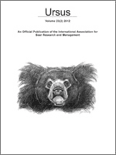
URSUS
Scope & Guideline
Uniting researchers to tackle pressing challenges in bear conservation.
Introduction
Aims and Scopes
- Bear Ecology and Behavior:
Research on the ecological roles, behavioral patterns, and social structures of various bear species, including their interactions with habitats and other wildlife. - Conservation and Management:
Studies focused on conservation strategies, population management, and human-wildlife conflict resolution, addressing the challenges bears face in changing environments. - Physiological and Health Studies:
Investigations into the health, nutrition, and physiological adaptations of bears, including their responses to environmental stressors and anthropogenic influences. - Genetic and Evolutionary Research:
Research exploring genetic diversity, phylogenetics, and evolutionary history of bear species, contributing to conservation genetics and species management. - Human-Bear Interactions:
Analysis of the dynamics between bear populations and human activities, including habitat encroachment, feeding behaviors, and conflict mitigation.
Trending and Emerging
- Impact of Anthropogenic Changes:
There is a growing emphasis on understanding how human activities, such as urbanization, agriculture, and climate change, affect bear behavior, health, and population dynamics. - Technological Advancements in Monitoring:
The use of technology, such as camera traps and genetic sampling, for monitoring bear populations and behaviors is increasingly prevalent, allowing for more effective research and conservation efforts. - Dietary and Nutritional Studies:
Research focusing on the dietary habits and nutritional needs of bears is trending, particularly in relation to habitat changes and food resource availability, which are critical for bear health and survival. - Social Structures and Interactions:
Emerging studies are delving into the social complexities of bear populations, revealing intricate social networks and interactions that influence their ecology and conservation. - Conflict Management Strategies:
With increasing human-bear interactions, there is a notable rise in studies aimed at developing effective conflict management strategies, addressing the urgent need to balance bear conservation with human safety.
Declining or Waning
- Historical Ecology of Bears:
Research focusing on the historical distribution and ecological roles of bears has become less prevalent, possibly overshadowed by contemporary conservation issues and urgent management needs. - In-depth Behavioral Studies:
While behavioral studies remain essential, there has been a noticeable reduction in detailed behavioral analyses, perhaps due to an increasing focus on applied conservation methods and management practices. - Diverse Habitat Studies:
The breadth of studies examining bears in various habitat types has decreased, particularly in less-studied regions, as researchers concentrate on more pressing ecological concerns.
Similar Journals
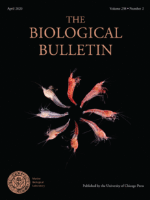
BIOLOGICAL BULLETIN
Elevating the discourse in agricultural and biological sciences.BIOLOGICAL BULLETIN is a premier journal published by The University of Chicago Press, catering to the vibrant field of Agricultural and Biological Sciences. Established in 1945, this long-standing publication has evolved to serve as a critical platform for disseminating cutting-edge research and insights across various biological disciplines. With a commendable impact factor and ranking in the top quartile (Q1) of its category, the journal is recognized for its rigorous peer-review process and its commitment to high-quality scholarship, ranking #74 out of 221 in the Agricultural and Biological Sciences category on Scopus. Researchers, professionals, and students will find a valuable resource in BIOLOGICAL BULLETIN, as it continually fosters scientific dialogue and innovation, ensuring the advancement of knowledge in the biological sciences. Although not openly accessible, the journal provides numerous access options for institutions and individuals wishing to engage with its content.

PAKISTAN JOURNAL OF ZOOLOGY
Advancing zoological knowledge for a sustainable future.Pakistan Journal of Zoology, established in 1975 and published by the Zoological Society of Pakistan, is a pivotal resource in the field of zoology and animal science, contributing to the academic discourse and research advancements in the region. With an ISSN of 0030-9923, this journal strives to disseminate innovative research findings and scholarly articles that explore various facets of animal biology, ecology, and conservation. Although classified in the Q4 quartile within the animal science category, its commitment to providing a platform for emerging researchers makes it crucial for those in the zoological community. The journal covers a broad range of topics relevant to contemporary issues in zoology, promoting both local and international collaborations. Situated in Lahore, Pakistan, its contributions are vital for promoting biodiversity awareness and conservation efforts within the region. Accessible research outputs empower students and professionals alike to engage in critical discussions and applications within the disciplines of zoology and animal science.

PACHYDERM
Connecting researchers to elevate the conservation of elephants.PACHYDERM is a reputable journal dedicated to the study and conservation of elephants, published by the esteemed IUCN-SSC Asian Elephant Specialist Group. It serves as a crucial platform for researchers, conservationists, and wildlife professionals to disseminate innovative findings and share insights into elephant ecology, behavior, and conservation strategies. Featuring an impressive scope from 2008 to 2015 and resuming from 2017 to 2023, the journal falls within the Q3 category of Animal Science and Zoology, reflecting its growing impact in the field with a Scopus rank of #367/490. Although currently not open access, PACHYDERM's content is vital for those committed to advancing our understanding and protection of these magnificent creatures. By fostering collaboration and highlighting critical research, PACHYDERM plays an integral role in promoting global awareness and conservation efforts surrounding elephants.
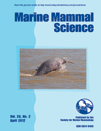
MARINE MAMMAL SCIENCE
Connecting science and conservation for marine mammals.MARINE MAMMAL SCIENCE, published by Wiley, is a premier journal dedicated to advancing the field of marine mammal research since its inception in 1985. With an impressive impact factor and categorized as Q1 in both Aquatic Science and Ecology, Evolution, Behavior and Systematics, this journal serves as a vital platform for innovative research and findings in marine biology, conservation, and ecology. It ranks 165th out of 721 in the Scopus category of Ecology, Evolution, Behavior and Systematics and 65th out of 247 in Aquatic Science, showcasing its influence and relevance in the academic community. Covering a wide range of topics, from behavior and anatomy to conservation and habitat management, MARINE MAMMAL SCIENCE aims to foster a deeper understanding and promote proactive strategies for the preservation of marine mammals. Researchers, professionals, and students will find invaluable insights and the latest advancements in this journal, contributing significantly to the discourse on marine conservation and ecology.

MAMMAL STUDY
Connecting researchers to promote mammalian science and ecology.Mammal Study, published by the Mammalogical Society of Japan, is a leading academic journal dedicated to the field of mammalogy and related biological sciences. Since its inception, it has provided a critical platform for researchers, professionals, and students to share their findings and insights into the diverse facets of mammalian biology, ecology, and conservation. The journal, with ISSN 1343-4152 and E-ISSN 1348-6160, is recognized for its rigorous peer-review process and has attained a commendable Q3 ranking in the 2023 category of Animal Science and Zoology. With an impact factor reflecting its growing influence—ranking 283 out of 490 in Scopus—we welcome contributions that advance the understanding of mammalian species and their habitats. While access to published articles is through traditional channels, the journal aims to reach an even wider audience by fostering greater awareness and appreciation for mammalian research and conservation efforts. The Mammal Study has converged years of insightful publications from 2008 to 2024, solidifying its position as a vital resource in the biological sciences.
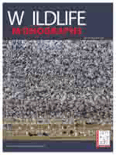
WILDLIFE MONOGRAPHS
Exploring the depths of biodiversity and ecosystem dynamics.WILDLIFE MONOGRAPHS, published by WILEY, is a prestigious journal dedicated to advancing the understanding of ecological and biological sciences with a keen focus on wildlife conservation and management. With an ISSN of 0084-0173 and an E-ISSN of 1938-5455, this journal has established itself as a leader in its field, ranking in the Q1 quartile for both Ecology, Evolution, Behavior and Systematics and Nature and Landscape Conservation in 2023. The journal's remarkable impact is underscored by its Scopus rankings—46th out of 721 in Agricultural and Biological Sciences and 17th out of 211 in Environmental Science, highlighting the journal's influential role in shaping research discussions and policy in wildlife management. Available in print and online, WILDLIFE MONOGRAPHS publishes comprehensive studies that inform practitioners, researchers, and students alike, fostering a deeper insight into biodiversity and ecosystem dynamics. Founded in 1981, the journal continues to evolve, contributing significantly to the scientific community through rigorous peer-reviewed articles that bridge the gap between theory and practical application in wildlife management.
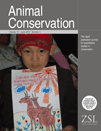
ANIMAL CONSERVATION
Innovating Conservation Strategies for Wildlife and Habitats.Animal Conservation is a prestigious journal that serves as a vital platform for the dissemination of research dedicated to the preservation of wildlife and habitats. Published by Wiley, this journal has established a significant presence in the fields of Ecology and Nature and Landscape Conservation, holding a distinguished Q1 category ranking for both in 2023. With an impressive Scopus rank of #25 in the realm of environmental science, it caters to a global audience keen on understanding and addressing pressing conservation issues. The journal provides researchers, professionals, and students with high-quality, peer-reviewed articles that explore innovative methods and strategies in animal conservation. With its continuous publication since 1998, encompassing a comprehensive range of topics, Animal Conservation is indispensable for anyone aiming to make impactful contributions to the field of ecology and conservation biology.

Journal of Wildlife and Biodiversity
Illuminating the path to ecological understanding.Journal of Wildlife and Biodiversity, published by Arak University in Iran, is an Open Access journal that has been contributing to the fields of wildlife science and biodiversity since its inception in 2017. With an E-ISSN of 2588-3526, this journal serves as a vital platform for researchers, professionals, and students alike, dedicated to disseminating significant findings related to animal sciences, ecology, and environmental conservation. Despite its current Q4 ranking in various categories (Animal Science, Ecology, and Nature and Landscape Conservation) according to the 2023 metrics, the journal's commitment to advancing knowledge in wildlife and biodiversity remains unwavering. Although the journal's Scopus coverage has been discontinued since 2024, it continues to cater to a wide audience by promoting innovative research and fostering collaborations in the academic community, ultimately aiming to enhance understanding and conservation strategies for wildlife and their habitats.

AUSTRALIAN JOURNAL OF ZOOLOGY
Bridging Research and Conservation for Wildlife SuccessAustralian Journal of Zoology, published by CSIRO PUBLISHING, serves as a premier platform for research in the fields of animal science and zoology, with a profound commitment to advancing our understanding of wildlife and ecosystems. Featuring an ISSN of 0004-959X and an E-ISSN of 1446-5698, this esteemed journal encompasses a wide range of topics relevant to ecology, evolution, behavior, and systematics. For the year 2023, it holds a commendable Q2 ranking in both Animal Science and Zoology and Ecology, Evolution, Behavior, and Systematics, demonstrating its significant impact within the academic community. With a rich publication history spanning from 1952 to 2024, the journal caters to researchers, professionals, and students by disseminating crucial findings and methodologies that contribute to effective conservation efforts and informed ecological practices. Although not an open access journal, it continues to foster collaboration and discussion among scholars in Australia and beyond. Located in Clayton, Victoria, the journal remains dedicated to its objective of enhancing knowledge in zoological sciences and addressing vital environmental challenges.

Human-Wildlife Interactions
Empowering Research to Enhance Human-Wildlife Harmony.Human-Wildlife Interactions, published by the JACK H BERRYMAN INST, is a leading open-access journal dedicated to the critical study and understanding of the complex relationships between humans and wildlife. Launched in 2007, the journal has become a pivotal platform for researchers, practitioners, and students in the fields of ecology and conservation. It is based in the heart of ecological research at Utah State University, bringing together diverse perspectives that illuminate both the challenges and solutions associated with wildlife interactions. With an impact factor reflected in its respectable Q3 ranking in Ecology and Nature and Landscape Conservation, it demonstrates a solid contribution to these scientific domains. Researchers exploring innovative conservation strategies, wildlife management practices, and the socio-economic impacts of wildlife are encouraged to submit their studies, enhancing the journal's role in fostering dialogue and advancing knowledge in this vital area of environmental science. Accessible to a global audience, Human-Wildlife Interactions continues to promote scholarly discourse in a way that supports the sustainable coexistence of people and wildlife in our shared environments.